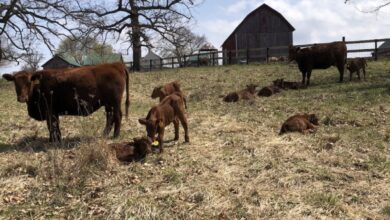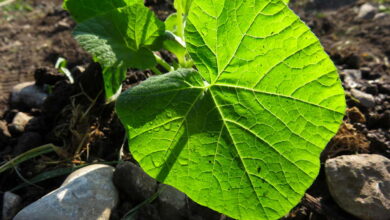A Story of the Death of Tillage

In spring of 1991, our farm changed forever.
Until then, Dad and Grandpa had been seeding with discers. These tools broadcast seeds on the ground, then flipped dirt over top of them. That’s it. To make this operation work, the field needed to be black – all remaining crop residue, such as straw, had to be broken up and incorporated. So, that meant lots of tillage. And, after seeding was complete, the field still needed to be harrowed and packed.
What exactly is tillage?
Tillage is a mechanical agitation of soil. In my wife’s garden, this could be from a rototiller, a hoe, even a shovel. In broadacre fields, this could be a cultivator, a disk, a plow, anything that turns the soil over and/or chops up straw. If you’ve ever worked in a garden or potted a plant, you have experienced tillage. The goal is a soft, loose bed of soil suitable for planting.
What’s the problem with tillage?
Tillage is inherently destructive. It breaks up the top layer of earth, shattering the soil structure, and generally killing anything living in it, from earthworms to microorganisms. It leaves the soil surface exposed, and vulnerable – you’ve seen the photos of the dust bowl. The great dust storms that blocked out the sun were a direct result of tillage.
Tillage was necessary at that time, and for most of agriculture’s history, because there were no other options for seedbed preparation and weed control. But that was about to change.
In 1991, after a decade of drought, dust storms, and failing farm profitability, Dad joined the growing number of farmers in Saskatchewan to abandon tillage for a new revolution: no-till.
Grandpa left for the cabin with Grandma for a few days in early May. Dad seized the opportunity to sell the discers and buy a no-till air seeder, as shown in the photo. Gone were the large, sharp disks, the need for black soil, and the need for the harrow/packer bar. In one pass, Dad could seed, fertilize, and pack. Grandpa didn’t think much of this snap purchase at the time, but gradually came around to the idea that tillage just wasn’t needed anymore.

How in the world did a change this significant happen?
The move away from tillage did not happen overnight, even though it looks that way now. It took many years – decades, in fact.
In 1993, Professor Les Henry wrote about “a quite revolution going on in the Canadian Prairies” in the March 1 edition of Grainews (thanks to Dr. Henry for providing me with a copy of the article). A few things had to happen for tillage to fade away in Western Canada. First, we needed cheaper herbicides. One of the key reasons tillage was done in the first place was for weed control. For crops to be successful, farmers needed to be able to seed into a seedbed free from weeds. Broad spectrum herbicides like glyphosate could do the job, but were just too expensive. Finally, in the early 1990’s, this was changing.
Another key factor needed was seeding implements. We needed air seeders that could plant into the previous year’s stubble – the residue left over from last year’s crop – without first breaking it up. This was finally happening too. Going along with that was the opportunity for better fertilizer placement, all in one pass.
The final key factor? A desire for change. Farmers needed a reason to switch to no-till. The 1980’s were the catalyst for that. A decade of drought, paired with poor profitability, caused by low prices and extremely high interest rates, pushed farmers to the breaking point. Seeing soil in the air in so many springs was wearing on them, too. Early adopters figured out the challenges with no-till, and many farmers began to join in. When Dad bought his Concorde air seeder in 1991, no-till was quietly taking over, just as Professor Henry wrote.
Farmers made the decision
Notice what’s absent here: the government. No one from the federal or provincial government walked into farmers’ yards and told them to stop tilling. No one forced or even incentivized farmers to make this massive change to their operations. Farmers saw an opportunity to do things better, to reduce their risk and make more money. This just happened to also be the best thing for the environment.
The thing is, in agriculture, these two things, economic and environmental sustainability, often go hand in hand. One of the most powerful things about farming is the generational legacy behind it – we stand on the shoulders of our grandparents to create a future for our children. If we don’t look after our soils, we will not survive long. Simple as that.
In my area, no-till quite literally saved our soils. We farm hardpan, saline soils that tillage was incredibly destructive to. Shifting from regular tillage to continuous cropping (as in, no years-off for our fields – they’re cropped every year) and direct seeding dramatically improved the ability for crop roots to penetrate and for water to percolate downwards. Our soils here don’t have a lot of extra organic matter. We cannot afford to lose any of it.
Today, no-till continues to be a core part of our production system. You can often see two years of straw on our soil surface – two different crop stubbles are there, together. It’s remarkable when you stop to think about that, and just how different it was just a few decades ago.

Is no-till perfect? Nope. It has its downsides. Nutrients, especially ones that don’t really move around like phosphorus, build up in the soil surface, leaving crops vulnerable to dry spells when phosphorus and other nutrients become unavailable. Herbicide resistant weeds are becoming a larger and larger problem, with no new active ingredients available to solve it. Sometimes, the fields are wet when we need access to them, and we create ruts – you need tillage to flatten them out.
Yes, sometimes, we do need to go in and till up parts of fields to fix problems. Sometimes, we need to harrow the soil surface to break up heavy straw so we can start seeding early in the wet, cool spring weather. There are no absolutes in this business.
And yes, in many areas, particularly in high rainfall zones and where the soil is heavy and crop yields are high, tillage is still a necessity. No-till is much harder when you get 20-40 inches of rain every year and grow 200 bushel per acre corn. I can only speak for what works here in much of Western Canada. In many regions, no-till just doesn’t work.
Making a choice
The thing I think is most worth highlighting though is that farmers made a choice – a choice to improve their livelihoods by doing the very best thing for the environment. We didn’t need the government to help us, and certainly not to force us, to do it. This is how it should be.
Farmers are incentivized to look after their soils and their environment because that is what enables us to build businesses that stand the test of time, that generate greater opportunities for our children than what we received. Involving the government in that just distorts and damages that incentive.
We don’t always get it right. We often make mistakes. But over time, the people making a living on the land will, in most cases, look after it the best. That’s what farming is all about – leaving things better than we found them.





